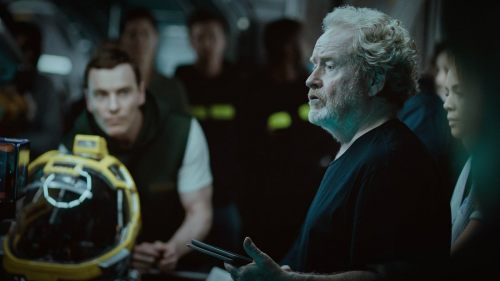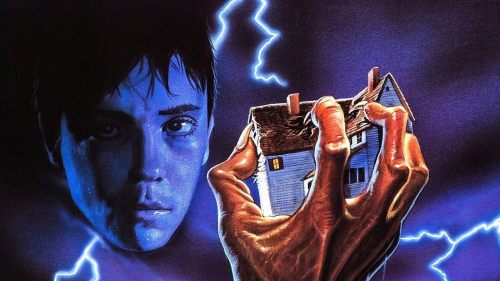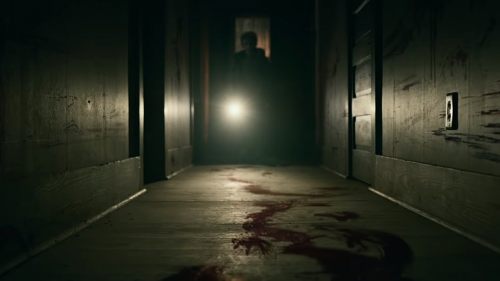Fantasia Fest: Guillermo Del Toro Loves Stabbing People
Guillermo del Toro is a guest of honour at this year’s Fantasia Fest, winning the Cheval Noir lifetime achievement award and appearing in the documentary Creature Designers: The Frankenstein Complex. In addition to a press conference, the acclaimed director also gave a 90-minute “masterclass” in which he spoke at length on a variety of topics and offered some sage advice for burgeoning filmmakers.
On designing monsters:
Given the documentary that preceded the presentation, the logical first topic was creature design. Del Toro focused on the importance of making creatures characters, with a range of emotional states, rather than “an angry fucking Halloween mask.” “The worst thing you can do is to sculpt a furrowed brow,” he said, “because then the monster has nowhere to go.” Del Toro’s creatures almost always have the ability to change their form in some way, whether it be unfurling wings, placing eyes in their hands, or opening up a set of mandibles, and that lends additional moments of surprise and delight for the audience.
He stressed the importance of grounding creature design in nature, because “nature has already designed the craziest monsters of all time.” Audiences instinctively read when creatures feel like they could really exist, and that’s largely down to using elements and ratios and weighting found in nature. An example given was the Knifehead kaiju in Pacific Rim, whose head and eye-to-mouth distance were designed with sharks in mind.
On being a learned director:
“As a director, you need to know everything about everything, and be able to articulate it.”
Del Toro’s advice on directing centred around knowledge: knowing what you want out of a movie, certainly, but also just plain knowing shit. Stressing the value for directors (“audiovisual writers”) of gathering visuals from a variety of sources, del Toro urged the audience to “milk the world for images,” from all art forms and from life itself, because “if you only gather from movies, all you can do is recycle images from other movies.” He rejected the notion that themes and visual motifs were self-indulgence, referring to them as “a compulsion” akin to a fetish.
Another form of knowledge del Toro stressed was that that comes from making mistakes and dealing with adversity. “The sun is gonna set at 7pm for [Kubrick] or me or you or Ed Wood,” he said, so there will always be compromises you have to make in order to finish your film. In Pan’s Labyrinth, for example, the frog character was supposed to appear in a grand set and hop around the place while interacting with Ofelia. The set was built and the shoot day came, but the frog puppet was so heavy as to be essentially inert. Rather than stick to the original plan and do it poorly, del Toro decided to relocate the character to a tree-root tunnel, using the puppet in a way that played to its strengths and weaknesses.
But no matter how many clever decisions you make, how many possessions or organs you sell to afford that one crucial shot (del Toro sold his van to get a shot of the interior of the Cronos device in Cronos), you’re never going to be able to get everything you want, and you’re probably going to fuck up somewhere. But as our host stated, very few people are ever perfect, and you learn through fucking up. “Success,” said del Toro, “is fucking up on your own terms.” As someone who spent five years labouring on a film and learning a ton of lessons along the way, I concur.
Audio commentaries got a big ol’ shout-out too. Claiming to have learned more from the Criterion Collection than he could have from film school, del Toro waxed lyrical about watching movies multiple times as a kid in order to dissect how they were constructed. And if you’re wondering: del Toro owns 7000 DVDs and Blu-Rays, 80 Laserdiscs, 20 VHS tapes and one Betamax (an otherwise-unavailable alternate cut of Frankenstein).
On politics:
One sort of horror del Toro shies away from is religious horror, because it’s too vague and too easy: “the easiest way you can get people scared is by invoking the Judeo-Christian notion of evil.” He does not believe that the devil is inherently evil and the church is inherently good, nor does he believe that monsters, ghosts, or even people are inherently good or evil. Rather, he posited, we’re good and bad, depending on the time of day or who or what we’re dealing with, and we’re in charge of making that call - not any kind of higher power. However, an easy round of applause came when del Toro stated that “any fucking institution is by definition corrupt and is there to fuck you up.”
Del Toro’s adherence to individualism continued in a brief tangent into politics. Stating that it was impossible to separate artistry and one’s political or social values, he entreated potential directors to “become politically engaged as a citizen and remain engaged as an artist.” He later joked, in a discussion on CGI, that if he could build a 25-foot robot for real, then he “would make some political change.”
On CGI vs practical effects:
Inevitably, a question arose about the push-pull relationship between practical effects and CGI. Del Toro’s response was ultimately that with whatever tools filmmakers use, they have to use them how the artistry demands. As a director known for using practical effects, it wasn’t surprising to hear him speak lovingly of the full-scale house set from Crimson Peak, which he considered a character in its own right, or describing digital as a “last resort.”
One observation he made - of which many people are likely unconsciously aware - was that while practical photography captures accidents organically, digital effects are “pure control, pretending to bring in accident” - meaning that everything in a digital effect has to be calculated and placed. We can just tell when simulated creatures, physics, or cameras (oh boy, don’t get me started on cameras) don’t behave in that slightly wobbly and imperfect way that real ones do, making it incredibly difficult to create digital effects that feel real.
And after all, “there are still people doing Grand Guignol theatre and puppet shows of a highly sophisticated level.” The old ways won’t die out; they’ll just find their place amongst an expanded set of tools.
On finding your story:
Easily the most personal question of the night was from an audience member trying to sort through dozens of story ideas and pick one on which to follow through. Del Toro’s answer was simple: tell the story you’re most afraid of. That’s not to say “do the scariest story” - it’s more about telling stories that reveal something about you that hurts. “If there’s something in a story that really fucks you up, you should do it,” said del Toro; “the only time you can make something worth telling is when you’re not doing some fucking cover of a famous fucking song.”
The audience member’s question is one that many creatives grapple with, and del Toro’s signifier of a strong idea - “This is uniquely me, and it hurts, and I don’t wanna do it, but I’ll do it” - is one I had not encountered before. Hopefully people take on that advice in a smart way and don’t churn out depressing self-indulgence.
On horror and comedy:
“Chaplin is one failed pratfall away from horror,” said del Toro when asked about the meeting of horror and comedy. He’s not wrong: anyone who’s watched Modern Times probably gasped during the roller-skating scene at the very least. There was quite a bit of talk about the relationship between horror and comedy: they both evoke primal responses (terror and laughter), and are both key elements of cinema.
Intriguingly, del Toro’s attitude is one that almost invites disaster. “Horror is always on the verge of being funny,” he said. “You have to go very close to ridicule, because if you don’t risk it, the image doesn’t have the power.” He brought up The Exorcist as an example of a film whose imagery is extremely risky, and could easily fall into the territory of ridicule, but ends up evoking horror. Del Toro admitted to not being very good at making movies both scary and funny, a technique which he described as “truly an art.”
Rather, his approach to violence is a little nastier: he wants people to relate to violence in a more personal way through unusual injuries. “I’m Mexican,” he said - “I love stabbing people.” Sharing a favourite anecdote of his, he talked about a time he hurt his armpit climbing a fence, “so I stab people in the armpit often.”
On Lovecraft:
Del Toro was asked whether, in the wake of his failed At The Mountains of Madness adaptation, he believed that Lovecraftian horror was simply too abstract to turn into cinema. Though his initial answer was “yes and no,” his reasoning tended towards “yes” - specifically that Lovecraft deals with the unknowable and unnameable, which by definition loses a great deal of power when shown onscreen. Decrying surface-level imitations, del Toro expressed admiration for films that come from “a deep understanding and love of [Lovecraft], not trying to imitate it,” citing The Thing, Alien, and Spring as Lovecraftian masterpieces. When adapting Lovecraft, he said, “you will fail a third of the people who love Lovecraft,” simply by dint of putting ideas meant to be imagined by readers onscreen in a tangible way.
Fans will be both pleased and dismayed to hear del Toro’s somewhat pessimistic plan for his Mountains adaptation. If it doesn’t get made in ten years, he says, he’ll publish a book with all the concept art and the screenplay. Much like Jodorowsky’s Dune, but actually available to the public.
On making video games:
Finally, del Toro spoke briefly about his experience working with Metal Gear Solid’s Hideo Kojima on the now-cancelled Silent Hills. Going into video games was something he wanted to do in order to learn more about storytelling, as - like animation, which he’s also worked in - taught him different things about stories and connecting with audiences. Games have different rules: they have to guide the audience along, while giving them the illusion of free will. If you want to feel even worse about the Silent Hills cancellation: del Toro said he and Kojima were “planning to fuck you up, man,” with the “scariest experience you could ever have playing.” He didn’t divulge any details of the game, joking that there could be a sniper in the theatre, but he seemed genuinely fond of the experience he had collaborating with Kojima and talking storytelling together.
And that’s approximately how I felt coming out of the theatre. Despite not being a the biggest fan of all del Toro’s films, I left inspired and energised by del Toro the person, wanting to make a dozen films right away. Cheers, Guillermo.



